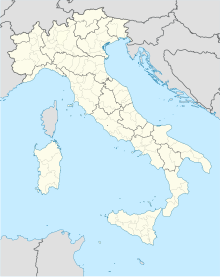 Country with institutions contributing to EGO and the Virgo Collaboration as of 2017 Country with institutions contributing to the Virgo Collaboration as of 2017 | |
| Formation | 1993 |
|---|---|
| Type | International scientific collaboration |
| Purpose | Gravitational wave detection |
| Headquarters | European Gravitational Observatory |
| Location | |
| Coordinates | 43°37′53″N 10°30′16″E / 43.6313°N 10.5045°E |
Region | Italy |
| Fields | Basic research |
Spokesperson | Gianluca Gemme |
| Affiliations | LVK (LIGO-Virgo-KAGRA collaboration) |
Budget | About ten million euros per year |
Staff | Around 880 people participate in the Virgo Collaboration |
| Website | www |
The Virgo interferometer is a large Michelson interferometer designed to detect the gravitational waves predicted by general relativity. It is in Santo Stefano a Macerata, near the city of Pisa, Italy. The instrument has two arms that are three kilometres long and contain its mirrors and instrumentation in an ultra-high vacuum.
Virgo is hosted by the European Gravitational Observatory (EGO), a consortium founded by the French Centre National de la Recherche Scientifique (CNRS) and the Italian Istituto Nazionale di Fisica Nucleare (INFN).[1] The Virgo Collaboration operates the detector, and defines the strategy and policy for its use and upgrades. The collaboration consists of more than 850 members in 16 countries.[2] The Virgo interferometer operates with similar detectors, including the two LIGO interferometers in the United States (at the Hanford Site and in Livingston, Louisiana) and the Japanese interferometer KAGRA (in the Kamioka mine). Cooperation between several detectors is crucial for detecting gravitational waves and pinpointing their origin; the LIGO and Virgo collaborations have shared their data since 2007, and with KAGRA since 2019, to form the LIGO-Virgo-KAGRA (LVK) collaboration.[3]
The interferometer is named after the Virgo Cluster, a cluster of about 1,500 galaxies in the Virgo constellation about 50 million light-years from Earth.[4] Developed when gravitational waves were only a prediction of general relativity, it has now detected several of them. Its first detection was in 2017 (together with the two LIGO detectors); this was quickly followed by the detection of the GW170817 gravitational wave, the only one observed with classical methods (optical, gamma-ray, X-ray and radio telescopes) as of 2024.[5] The detector is used for joint observing runs with the other detectors, separated by commissioning periods during which it is upgraded to increase its sensitivity and scientific output.[6]
- ^ "Our mission". www.ego-gw.it. European Gravitational Observatory. Retrieved 11 October 2023.
- ^ "The Virgo Collaboration". virgo-gw.eu. The Virgo Collaboration. 18 February 2021. Retrieved 11 October 2023.
- ^ Cite error: The named reference
dcc.ligo.orgwas invoked but never defined (see the help page). - ^ "Virgo Interferometer for the Detection of Gravitational Waves". eoPortal. 1 April 2019. Retrieved 26 July 2024.
- ^ Cite error: The named reference
Abbott-2017bwas invoked but never defined (see the help page). - ^ Cite error: The named reference
observing.docs.ligo.orgwas invoked but never defined (see the help page).
